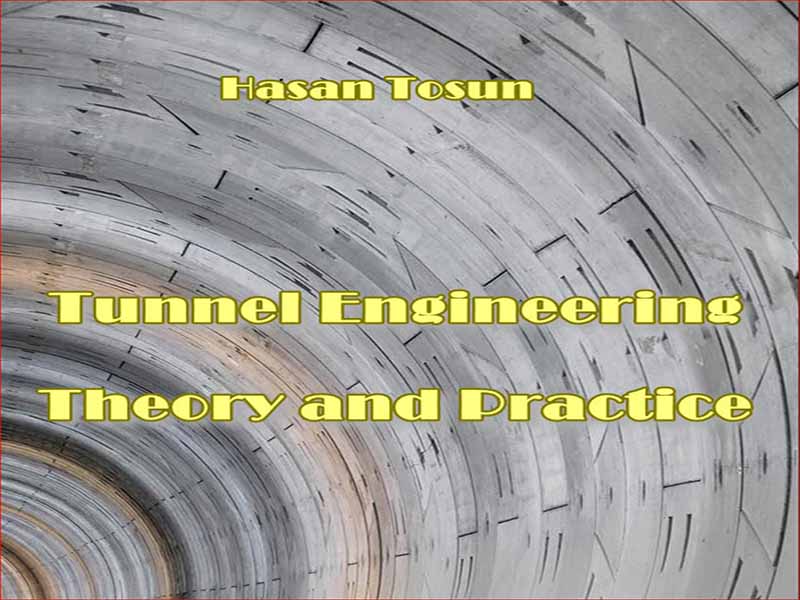- عنوان کتاب: Tunnel Engineering Theory and Practice
- نویسنده: Hasan Tosun
- حوزه: ساخت تونل
- سال انتشار: 2022
- تعداد صفحه: 72
- زبان اصلی: انگلیسی
- نوع فایل: pdf
- حجم فایل: 6.79 مگابایت
طراحی یک دهانه زیرزمینی با سایر سازه های مهندسی ساخته شده بر روی سطح زمین متفاوت است. برای سازه های زیرسطحی، بارهای ناشی از فشار اضافه بار و بارهای اضافی در نظر گرفته می شود و سیستم/سیستم های پشتیبانی برای پاسخگویی به این بارهای کل طراحی شده اند، در حالی که در سازه های سطحی مانند سدها، پل ها و ساختمان ها طراح باید بارهای ناشی از آن را منتقل کند. سازه های مربوط به عناصر پی در زیر زمین. به عبارت دیگر، سازه های زیرزمینی در داخل زمین با پارامترهای ناشناخته بسیاری ساخته می شوند. اما سازه های سطحی با مصالحی طراحی می شوند که خواص آنها به خوبی شناخته شده است و ابعاد سازه با توجه به ظرفیت باربری زمین زیر سازه های مربوطه قابل کنترل است. بنابراین، برآورد بار سنگ موضوع بسیار مهم تری در طراحی سازه های زیرزمینی است. علاوه بر این، مشکلات معمولی می تواند به دلیل نوع سنگ، ویژگی های ساختاری در توده سنگ و سن تشکیل سنگ ایجاد شود. مثلا؛ سنگهای قدیمیتر با سن پرکامبرین و پالئوزوئیک میتوانند منجر به فشار فشردگی عظیمی شوند در حالی که اثر قوس در سنگهای رسوبی جوان ایجاد نمیشود. در طراحی سازه های زیرزمینی و همچنین برآورد بار سنگ، عمق زون از دست رفته، اثر قوس و اندرکنش تکیه گاه سنگ نیز به عنوان یک معیار مهم طراحی ظاهر می شوند. برای این منظور روش های بسیاری بر اساس واقعیت های کشور و منطقه پیشنهاد شده است. به عنوان مثال، در عمل آمریکای شمالی، طراحی پشتیبانی با دنده های فولادی بسته به کلاس های سنگ ساده تعریف شده در نظر گرفته شده است، در حالی که در تونل سازی اروپای مرکزی، طراحی سیستم های پشتیبانی انعطاف پذیر مانند پیچ های سنگی، شاتکریت و مش سیمی برای تشکیل منطقه خود حمل در اطراف دهانه بسته به خواص فیزیکی و مکانیکی مواد حفاری شده، ناپیوستگی توده سنگ و ویژگی های مکانیکی سیستم پشتیبانی. در روشهایی که طراحی تکیهگاه انعطافپذیر را پیشبینی میکنند، هدف آن است که تنشهای ایجاد شده در اطراف دهانه زیرزمینی را با خود تحمل بار سنگ متعادل کرده و به راهحلهای اقتصادیتر دست یابیم. مطالعات متعددی در مورد قابلیت اطمینان و صرفه جویی این روش های پیشنهادی انجام شده است [1-15]. این کتاب شامل چهار مقاله عالی در مورد مسائل ویژه مهندسی تونل است. هدف کلی این مجموعه بهبود تئوری و عملی سازه های زیرزمینی است. این مقالات فصلهایی را در مورد روشهای تحلیلی و عددی برای برآورد بار سنگ و سیستمهای پشتیبانی طراحی و پیشرفت در سیستم اندازهگیری سازههای زیرزمینی پوشش میدهد.
The design of an underground opening differs from that of other engineering structures constructed on the ground surface. For subsurface structures, loads caused by overburden pressure and surcharge loadings are taken into account, and support system/systems are designed to meet these total loads, while in surface structures such as dams, bridges, and buildings the designer has to transfer loads caused by the relevant structures to the foundation elements beneath ground. In other words, underground structures are constructed within the ground with many unknown parameters. However, surface structures are designed with materials whose properties are known very well and structure dimensions can be controlled according to the bearing capacity of the ground below the relevant structures. Therefore, rock load estimation is a much more important issue in the design of underground structures. Additionally, typical problems can arise due to the type of rock, structural features in the rock mass, and age of rock formation. For example; older rocks with Precambrian and Paleozoic age can result in huge squeezing pressure while the arching effect cannot be formed in young sedimentary rocks. In the design of underground structures, as well as rock load estimation, the depth of losing zone, the arching effect, and rock-support interaction also emerge as an important design criteria. For this purpose, so many methods based on country and region facts have been suggested. For example, in North American practice, support design with steel ribs is envisaged depending on the defined simple rock classes, while in Central European tunneling, the design of flexible support systems such as rock bolts, shotcrete, and wire mesh was adopted to form a self-carrying zone around the opening depending on physical and mechanical properties of excavated material, discontinuities of rock mass and mechanical characteristics of support system. In the methods that envisage flexible support design, it is aimed to balance the stresses formed around the underground opening by self-bearing the rock load and to achieve more economical solutions. Numerous studies have been conducted on the reliability and economy of these proposed methods [1– 15]. This book includes four excellent contributions on the special issues of Tunnel Engineering. The overall aim of the collection is to improve the theory and practice of underground structures. The articles cover Chapters on analytical and numerical methods for rock load estimation and design support systems and advance in the measurement system for underground structures.
این کتاب را میتوانید از لینک زیر بصورت رایگان دانلود کنید:
Download: Tunnel Engineering Theory and Practice




































نظرات کاربران